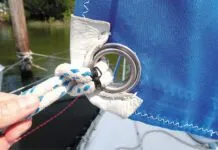Keeping Props Clean
On page 11 of the November 1, 1998 issue, there is a photo of the Max-Prop. It has “new zincs, a grease job, and a thorough polish.” Is this the state in which it is put into operation or is antifouling next applied? If so, how? I have been using one of these engineering delights for the last eight years in south Florida and Bahamian waters and have been quite unable to come up with a technique that retains the antifouling finish for more than 2-3 months. Is there any solution that does not involve flippers, face mask and scrub pads?
Jerry Cuffe
Stuart, Florida
There are a number of approaches to keeping propellers free of barnacles, but none we are confident of. For this reason, we are planning tests of several methods, including copper plating (offered by several firms) and a few new brush-on products. Some people paint their props with conventional antifouling paint, but it doesn’t seem to hold well.
One method that readers report working is to remove the zinc from the prop shaft and electrically isolate the shaft from the engine (by means of a non-conductive spacer, such as the Driver Saver from Globe Rubber Works (254 Beech Hill, Rockland, MA 02370-0183; 781/871-3700). Because the bronze propeller and stainless steel shaft are slightly apart on the galvanic scale, a small electrical differential develops, which seems to discourage barnacles. The less noble bronze is theoretically at risk, but readers report that even after 3-4 years they cannot detect any damage to their props. (One would certainly hope so, given the cost of a Max-Prop!) The reason for electrically isolating the engine is to protect the iron or aluminum engine block. Then, of course, the block cannot be used as ground for the electrical system; you’d have to use the keel (if external) or install a separate grounding plate.
Until we complete our tests, the fall-back position is to polish the prop as best one can. A smooth surface resists barnacles better than a pitted one. Running the engine and turning the prop regularly also helps. Left idle for long periods is an invitation to barnacles to move in and glom on.
Limit of Positive Stability
I noticed in your review of the Sabre 362 in the January 1, 1999 issue, you state “The boat’s limit of positive stability is about 118, close to the 120 number we consider a minimum.” Could you explain what the limit of positive stability is more thoroughly, as well as how one would compute it from normal data provided by a boat’s manufacturer.
Sam Schleman
via e-mail
The limit of positive stability (LPS) cannot be calculated from basic boat specs. The best way to get the number for your boat is to have it measured for an IMS racing certificate. Alternatively, you can call US Sailing (401/683-0800) to see if they have measurements on file for any sisterships.
The LPS number is the angle of heel in degrees from which the boat should recover to an upright position. If the number is 120, and the boat rolls beyond that angle, it will capsize (turn over or turtle). This doesn’t mean the boat won’t come back upright from a capsize, but it does indicate its likelihood of capsize in severe conditions. A boat with only 100 LPS is more likely to capsize than a boat with 120 LPS. Our 120 target number is arbitrary, but based on analysis of many designs and of capsize records.
Over the years there have been other formulas developed, such as the capsize screening formula devised by the Society of Naval Architects and Marine Engineers, but they were controversial and dismissed as too simple. With any formula, however, boats with excessive beam to length ratios (fat boats), especially those with flush or near flush decks, are deemed more likely to capsize and possibly stay in a stable, inverted state, than narrower, deeper boats with conventional cabin tops.


































